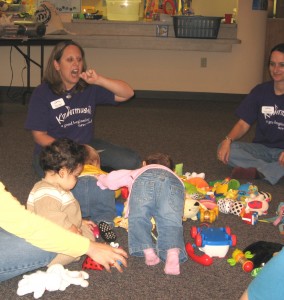Tag: asl
Sign and Sing : Some Questions Answered
Hi everyone!
I am currently accepting enrollments for our next Sign and Sing workshop which begins on Wednesday, November 14th and thought, this would be a PERFECT time and place to address some questions and concerns that parents sometimes have about babysigning in general. I am approaching my 7th time teaching this workshop. At the beginning of my journey with Sign and Sing, I was even a bit skeptical. I wondered if it really works or does it delay a child’s speech? As a parent of two, I didn’t use babysigning with my daughter Anna, who is now 6. She was an early talker, so I didn’t even think it was a topic that pertained to our situation. My son Aiden however, is taking his time talking. He is currently 2 1/2 and even now most people aren’t sure what he is saying. His words aren’t quite clear yet, even though he is talking. Both of my children fall into the “normal” developmental range for the onset of talking. Every baby crawls, talks, walks, etc. in their own time. Over the course of my Sign and Sing journey so far, I have learned that if I had done babysigning with Anna, it would have only helped her speech and giving her an opportunity for long term learning. For Aiden it was AMAZING! I started teaching this course at JUST the right time because I could use Aiden as my “practice baby”. My husband embraced it as well, as did Anna, and our household starting signing. Boy did we eliminate lots of tantrums with Aiden. He was able to tell us when he was “all done”, or if he wanted “more” without crying or yelling. All babies are going to communicate. Before they can talk, the only way for them to express their needs is to cry, yell, tantrum. Well, Signing is a nice, calm and quiet alternative to all of that!!
Now to maybe clarify some myths that are out there!
The assumption that babysigning will DELAY speech is a complete myth.
A parent once asked….“so I would think talking to them and encouraging them to speak (reading to them consistently is proven to build language), would be more beneficial to them then encouraging them to sign instead”. Parents with hearing children are NEVER encouraged to sign INSTEAD of speaking. It is SO important to note that. What we do is encourage parents to speak WHILE signing. That is why, in our Sign and Sing class, we sing our songs, while we sign. The children then associate the speech to the signs. By doing this, we are giving them another form of communicating. In no way are we discouraging speaking! All babies need to express their needs. Most babies and toddlers are not able to do this specifically with speech for quite a long time, so their instinctual response is to scream, cry or tantrum. The biggest reason for meltdowns and tantrums in toddlers are simply because the child cannot communicate their needs properly. As Dr. Greene says, “Their ideas far outstrip their language skills. The “terrible twos” are less terrible the more children learn how to get across their intense and conflicting thoughts. Baby signs are a wonderful way to do this. Shaking the head or moving the hand is far easier to learn than the intricate manipulation of the lips, jaw, and tongue necessary for each new word. Large muscle coordination is learned before small muscle coordination – at about the same time kids want to express themselves.”
Compared to developmental norms, Signing Smart children have enriched language and communication skills:
- While the average 8 month old will have no spoken words, the average Signing Smart child will have 5 signs and 1 word.
- While the average 12 month old will have 3-5 spoken words, the average Signing Smart child will have 25 signs and 16 words
- At 18 months, the average child will have 10-50 spoken words. In contrast, the average Signing Smart child will have 79 signs and 105 words.
- In addition, a majority of Signing Smart children begin combining signs and words or signs and signs together to form little sentences at 11-14 months. Compare this to non-signers, who do not begin to combine words into short sentences (e.g., “Da-da car”) until 20 months old on average!
These results indicate that ASL signs, used in combination with Signing Smart strategies, facilitate both overall communicative abilities as well as spoken language skills in hearing infants and toddlers.

Here are some links to answer even more questions:
